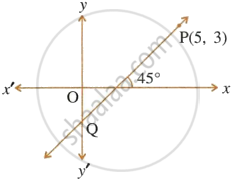Advertisements
Advertisements
प्रश्न
The line passing through (0, 2) and (−3, −1) is parallel to the line passing through (−1, 5) and (4, a). Find a.
उत्तर
Slope of the line passing through (0, 2) and (−3, −1)
= `(-1 - 2)/(-3 - 0)`
= `(-3)/(-3)`
= 1
Slope of the line passing through (−1, 5) and (4, a)
= `(a - 5)/(4 + 1)`
= `(a - 5)/5`
Since, the lines are parallel.
∴ `1 = (a - 5)/5`
a – 5 = 5
a = 10
APPEARS IN
संबंधित प्रश्न
Find the slope of the line with inclination 30° .
Show that the points P(a, b + c), Q(b, c + a) and R(c, a + b) are collinear.
The line through P(5, 3) intersects y-axis at Q.
- Write the slope of the line.
- Write the equation of the line.
- Find the co-ordinates of Q.

Find the slope of the line which is perpendicular to `x/3 - 2y = 4`
Find the slope of the lines passing through the given point.
T (0, –3) , S (0, 4)
Find k, if R(1, –1), S (–2, k) and slope of line RS is –2.
Find k, if PQ || RS and P(2, 4), Q (3, 6), R(3, 1), S(5, k).
Find the slope of a line, correct of two decimals, whose inclination is 75°
Find the slope and the y-intercept of the following line x - 2 = `(5 - 3"y")/2`
The line through P (5, 3) intersects Y axis at Q.
(i) Write the slope of the line.
(ii) Write the equation of the line.
(iii) Find the coordinates of Q.
